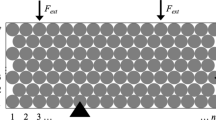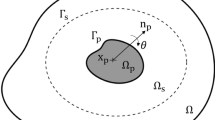Abstract
The fracture resistance of structures is optimized using the level-set method. Fracture resistance is assumed to be related to the elastic energy released by a crack propagating in a normal direction from parts of the boundary that are in tension, and is calculated using the virtual crack extension technique. The shape derivative of the fracture-resistance objective function is derived. Two illustrative two-dimensional case studies are presented: a hole in a plate subjected to biaxial strain; and a bridge fixed at both ends subjected to a single load in which the compliance and fracture resistance are jointly optimized. The structures obtained have rounded corners and more material at places where they are in tension. Based on the results, we propose that fracture resistance may be modeled more easily but less directly by including a term proportional to surface area in the objective function, in conjunction with nonlinear elasticity where the Young’s modulus in tension is lower than in compression.
Similar content being viewed by others
References
Allaire G (2001) Shape optimization by the homogenization method. Springer, New York
Allaire G, Jouve F (2005) A level-set method for vibration and multiple loads structural optimization. Comput Methods Appl Mech Eng 194:3269–3290
Allaire G, Bonnetier E, Francfort G, Jouve F (1997) Shape optimization by the homogenization method. Numer Math 76:27–68
Allaire G, Jouve F, Toader AM (2002) A level-set method for shape optimization. C R Acad Sci Paris Ser I 334:1125–1130
Allaire G, Jouve F, Toader AM (2004) Structural optimization using sensitivity analysis and a level-set method. J Comput Phys 194:363–393
Allaire G, de Gournay F, Jouve F, Toader AM (2005) Structural optimization using topological and shape sensitivity via a level set method. Control Cybern 34(1):59–80
Amstutz S, Andrä H (2006) A new algorithm for topology optimization using a level-set method. J Comput Phys 216:573–588
Bendsøe MP (1989) Optimal shape design as a material distribution problem. Struct Optim 1:193–202
Bendsøe MP, Kikuchi N (1988) Generating optimal topologies in structural design using a homogenization method. Comput Methods Appl Mech Eng 71:197–224
Bendsøe MP, Sigmund O (1999) Material interpolations in topology optimization. Arch Appl Mech 69:635–654
Bendsøe MP, Sigmund O (2004) Topology optimization, 2nd edn. Springer, Berlin Heidelberg New York
Bendsøe MP, Lund E, Olhoff N, Sigmund O (2005) Topology optimization—broadening the areas of application. Control Cybern 34(1):7–35
Burger M, Hackl B, Ring W (2004) Incorporating topological derivatives into level set methods. J Comput Phys 194:334–362
Céa J (1986) Conception optimale ou identification de formes, calcul raide de la dérivée directionnelle de la fonction coût. Math Model Numer Anal 20:371–402
Garboczi EJ (1998) Finite element and finite difference programs for computing the linear electric and elastic properties of digital images of random materials. Technical report, NISTIR 6269. http://ciks.cbt.nist.gov/garbocz/manual/man.html
Garboczi EJ, Day AR (1995) An algorithm for computing the effective linear elastic properties of heterogeneous materials: three-dimensional results for composites with equal phase poisson ratios. J Mech Phys Solids 43:1349–1362
Gomes AA, Suleman A (2006) Application of spectral level set methodology in topology optimization. Struct Multidisc Optim 31:430–443
de Gournay F (2006) Velocity extension for the level-set method and multiple eigenvalues in shape optimization. SIAM J Control Optim 45:343–367
Griffith AA (1921) The phenomena of rupture and flow in solids. Philos Trans R Soc Lond A 221:163–198
Guo X, Zhao K, Wang MY (2005) A new approach for simultaneous shape and topology optimization based on dynamic implicit surface function. Control Cybern 34(1):255–282
Hellen TK (1975) On the method of virtual crack extensions. Int J Numer Methods Eng 9:187–207
Hintermüller M (2005) Fast level set algorithms using shape and topological sensitivity information. Control Cybern 34:305–324
Lawn BR (1993) Fracture of brittle solids, 2nd edn. Cambridge University Press, Cambridge, UK
Murat F, Simon S (1976) Etudes de problèmes d’optimal design. Lecture Notes in Computer Science, vol. 41. Springer, Berlin
Osher SJ, Santosa F (2001) Level set methods for optimization problems involving geometry and constraints I. frequencies of a two-density inhomogeneous drum. J Comput Phys 171:272–288
Osher SJ, Sethian JA (1988) Fronts propagating with curvature dependent speed: Algorithms based on the Hamilton–Jacobi formulation. J Comput Phys 79:12–49
Parks DM (1974) A stiffness derivative finite element technique for determination of crack tip stress intensity factors. Int J Fract 10:487–502
Rice JR (1968) A path independent integral and the approximate analysis of strain concentration by notches and cracks. J Appl Mech 35:379–386
Samet B (2003) The topological asymptotic with respect to a singular boundary perturbation. C R Acad Sci Paris Ser I 336:1033–1038
Sethian JA, Wiegmann A (2000) Structural boundary design via level set and immersed interface methods. J Comput Phys 163(2):489–528
Simon J (1980) Differentiation with respect to the domain in boundary value problems. Numer Funct Anal Optim 2:649–687
Sokołowski J, Zolesio JP (1992) Introduction to shape optimization: shape sensitivity analysis. In: Springer series in computational mathematics, vol. 10. Springer, Berlin Heidelberg New York
Suzuki K, Kikuchi N (1991) A homogenization method for shape and topology optimization. Comput Methods Appl Mech Eng 93:291–318
Wang MY, Wang X (2004) “Color” level sets: a multi-phase method for structural topology optimization with multiple materials. Comput Methods Appl Mech Eng 193:469–496
Wang MY, Wang X (2005) A level-set based variational method for design and optimization of heterogeneous objects. Comput-Aided Des 37:321–337
Wang S, Wang MY (2006a) A moving superimposed finite element method for structural topology optimization. Int J Numer Methods Eng 65:1892–1922
Wang S, Wang MY (2006b) Radial basis functions and level set method for structural topology optimization. Int J Numer Methods Eng 65:2060–2090
Wang SY, Wang MY (2006c) Structural shape and topology optimization using an implicit free boundary parameterization method. Comput Model Eng Sci 13(2):119–147
Wang MY, Wang X, Guo D (2003) A level set method for structural topology optimization. Comput Methods Appl Mech Eng 192:227–246
Wang X, Wang MY, Guo D (2004) Structural shape and topology optimization in a level-set-based framework of region representation. Struct Multidisc Optim 27:1–19
Wang MY, Chen SK, Wang XM, Mei YL (2005) Design of multimaterial compliant mechanisms using level-set methods. J Mech Des 127:941–956
Wilke DN, Kok S, Groenwold AA (2006) A quadratically convergent unstructured remeshing strategy for shape optimization. Int J Numer Meth Eng 65:1–17
Yulin M, Xiaoming W (2004) A level set method for structural topology optimization and its applications. Adv Eng Softw 35:415–441
Author information
Authors and Affiliations
Corresponding author
Rights and permissions
About this article
Cite this article
Challis, V.J., Roberts, A.P. & Wilkins, A.H. Fracture resistance via topology optimization. Struct Multidisc Optim 36, 263–271 (2008). https://doi.org/10.1007/s00158-007-0160-0
Received:
Revised:
Accepted:
Published:
Issue Date:
DOI: https://doi.org/10.1007/s00158-007-0160-0




